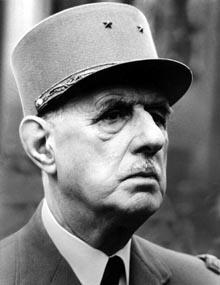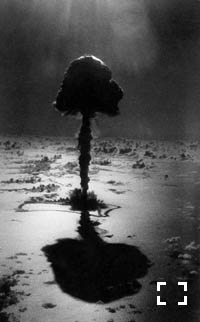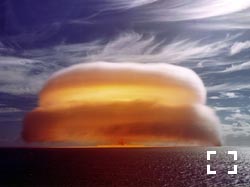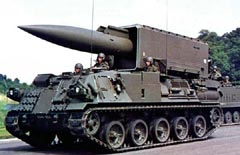 |
|
France's Nuclear Weapon Program
France was the fourth nation to join the nuclear club when it successfully detonated a large nuclear
device in Algeria in 1960 (Gerboise Bleue ). Officially recognized as a nuclear weapon state by the Non
-Proliferation Treaty (NPT), France currently stockpiles approximately 350 warheads, down from some 540
in 1992. France has produced approximately 1,260 nuclear warheads since 1964 and conducted 210 nuclear
tests since 1960.
France developed nuclear weapons to serve as a nuclear deterrent independent of the United States and
Great Britain. This independent deterrent, known as the Force de Frappe, was seen as a means for France
to maintain the freedom it required to defend its own interest. At first, these nuclear
weapons served solely for the defense of France but later served for the defense of Western Europe,
primarily against Soviet aggression during the Cold War. Initially, when President Charles de Gaulle
established this independent nuclear capability, it was never integrated with NATO policies and plans.
France also never sought to engage in nuclear arms competitions between the Soviet Union and the United
States.
France's nuclear arsenal remained primarily political in nature and was intended to dissuade militarily
stronger powers from risking an attack on vital French interests. This doctrine was known as Dissuasion
- the French term for deterrence. Several political and military officials were unsuccessful in efforts
to expand the role and develop low-yield tactical nuclear weapons to dissuade weaker nations, such as
several north African countries.
"The Americans and the Russians could destroy the earth 1000 times over.
France could only do it once - but that is enough."
- Pierre Lacoste, French Military Strategy Advisor (1966-1972)
|
This minimal dissuasion policy has not only influenced French nuclear forces during the Cold War, but
also has resulted in major reductions in France's nuclear forces and infrastructure in recent years.
With the collapse of the Soviet Union and end of the Cold War, France has not been faced with a major
external threat, bringing into question the need of France's independent nuclear arsenal.
These changes also reflect in a reduced defense budget, and a shift in priorities toward modernization of
conventional forces. France has eliminated spending on its nuclear weapons program by more than 50
percent, eliminated land-based nuclear missiles, reduced from six to four plans to build new ballistic
missile submarines and is in the process of closing plants that produce fissile material for nuclear
warheads. These changes in policies and force posture indicate that nuclear weapons in France no longer
play the prominent role that they once did during the Cold War. However, a broadly based consensus in
France favors retaining these weapons as the ultimate role in security guarantee.
"No country without an atom bomb could properly consider itself independent"
- Charles De Gaulle (1968)
|
|

Charles De-Gaulle
|
Before World War II, France was a leading nation in nuclear research, mainly due to breakthrough
research by Pierre and Marie Curie. Their daughter and son-in-law, Irène Joliot-Curie and Frédéric
Joliot-Curie, conducted important research into the structures of atoms, particularly neutrons, for
which they won the 1935 Nobel Prize in Chemistry. However, when war broke out in 1939 and with the
German occupation of France in 1940, nuclear research was halted. Meanwhile, American and British
nuclear research moved ahead at a frantic rate during the Manhattan Project. Soviet research also moved
ahead as spies working inside Los Alamos leaked great quantities of information. Charles De Gaulle had
been informed of the progress of nuclear research in the United States and its military implications.
On October 18, 1945, President and General Charles de Gaulle authorized the creation of the Commissariat
a l’Energie Atomique (CEA), the first civilian controlled atomic energy authority ever established. The
CEA was responsible for both military and civilian applications of nuclear energy. In 1949, a plutonium
research facility was constructed by the CEA at Le Bouchet and later industrial scale plutonium
production facilities were authorized to be built near Marcoule. These plants were intended to produce
50 kilograms of plutonium a year, which was enough to make between six and eight nuclear bombs.
The first milligram of plutonium was extracted from the ZOE reactor on November 20, 1949.
Prime Minister Pierre Mendes authorized the program to develop nuclear weapons after a meeting with his
cabinet on December 26,1954. Two days later, the Bureau of General Studies was created to pursue the
project. Large amounts of funds were transferred to the nuclear weapons project in 1955. After the Suez
Crisis in October 1956, nuclear weapons research intensified. On November 30, 1956, the CEA and Ministre
des Armees signed a memorandum committing them to test a nuclear weapon. The Committee for the Military
Applications of Atomic Energy was secretly created on December 5, 1956. This committee allowed for
greater cooperation between the CEA and senior military officials and the official order to manufacture
and test a nuclear weapons was signed on April 11, 1958 by Prime Minister Felix Gaillard.

Canopus - 24/08/1968
|
General Charles de Gaulle became President of the Council of Ministers on May 31, 1958 after being
charged with forming a new government after the collapse of the Fourth Republic. On December 21, 1958,
de Gaulle became the first President of France. Shortly after this time, de Gaulle created the Force de
Frappe. The Force de Frappe was an independent nuclear force. NATO was seen at the time by France as
being dominated by the United States to an unacceptable degree. On February 13, 1960, France detonated a
nuclear bomb and became a nuclear power. Eight years later, France would detonate a hydrogen bomb in the
South Pacific.
France has since dismantled its land-based ballistic missiles and retired its nuclear bombs intended for
delivery by naval strike aircraft in the last decade. France initially planned to arm its M-51 SLBM,
which is scheduled for deployment in 2010, with an entirely new warhead, the Tête Nucléaire Océanique
(TNO). However, this missile will instead be equipped with a more robust version of an existing design,
probably the TN-75.
The end of the Cold War initiated a revision of previous nuclear doctrines to deal with the threat of
rogue states with weapons of mass destruction. In January 2006, President Jacques Chirac gave a warning
states sponsoring terrorism that France was prepared to launch a nuclear strike against any country that
sponsors a terrorist attack against French interests. France's next generation of nuclear weapons will
be configured for tactical nuclear strikes against possible terrorist targets and rogue states.
In September 1996, France signed the Comprehensive Test Ban Treaty. In 1998, France ratified the treaty,
effectively ending its nuclear testing program. To meet the challenges of maintaining a reliable enduring stockpile without live nuclear testing, France has undertaken an ambitious program called the Simulation Program. The main objectives of the Simulation program is to replace current weapons systems when they come to the end of their life and to maintain advanced scientific capability in order to guarantee the reliability and safety of current systems and the systems that will replace them.
The Simulation program will use the Tera-10 supercomputer, the most powerful machine in Europe, to guarantee the safety and reliability of nuclear weapons with the need for live nuclear testing. The Tera-10 machine is installed in the DAM/Île de France Center in Bruyères-la-Châtel, within CEA's Scientific Computing Complex. The program will also include a high-power laser and a powerful radiography machine (AIRIX). The Simulation program will not allow for the conception of new designs or the development of entirely new types of warheads.
Testing
Since 1960, France has conducted 210 nuclear tests. France's nuclear tests have accounted for approximately 10% of all nuclear tests conducted since 1945. The total cumulative yield of the 210 nuclear tests is ~14 megatons, with atmospheric nuclear tests accounting for approximately 10 megatons. The largest nuclear test, code named Canopus, was fired on August 24, 1968 and had a yield of 2.6 megatons.
France conducted its nuclear testing program at two main locations. Algeria was selected in 1958 to be
the location of the nuclear tests. In 1966, nuclear testing was moved to the South Pacific at the
uninhabited atolls of Mururoa and Fangataufa, called the CEP (Centre d'Experimentation du Pacifique/
Pacific Test Center). Between 1966 and 1996, France's entire nuclear testing program was located at the
CEP.
France's nuclear testing series can be divided into four distinct periods by date and location:
1960 – 1961: Algeria – 4 atmospheric nuclear tests
1961 – 1966: Algeria – 13 underground nuclear tests
1966 – 1974: South Pacific – 41 atmospheric nuclear tests
1974 – 1996: South Pacific – 152 underground nuclear tests
The Kerguelen Islands in the Indian Ocean, Clipperton Island and the Taumotu Archipelago in the South
Pacific, and French Algeria were all initially considered as possible test sites during the 1950s. Due
to the lack of a suitable airfield, Clipperton and the Tuamotu Archipelago were initially ruled out. The
Kerguelen Islands were too remote and lacked suitable meteorological conditions. In 1957, Algeria was
chosen as France's nuclear test site and in April 1958 the French government set a goal to conduct a
nuclear test in the first quarter of 1960.
To prepare for their nuclear tests, several French delegations visited and participated in U.S. Nuclear
tests at the Nevada Test Site during operations Plumbbob and Hardtack II. These visits provided an
orientation in nuclear test effects. During shot Smokey (August 31, 1957), the French tested a selection
of their underground personnel shelters, equipment, and test instrumentation.
1960-1961: French Atmospheric Testing Series - Algeria
Algeria, which belonged to France since 1830, was chosen as the location to conduct the first nuclear
tests. The Algerian War of Independence, initiated by the FLN (Front de Libération Nationale), had been
waging since 1954. The war marked a time of guerrilla warfare and terrorist strikes conducted at
civilians from both pro-colonists and pro-independence forces. Despite this period of turmoil, France decided to conduct its first nuclear tests there. A nuclear testing site in France was not possible as the nation's relatively small size and close proximity of populated areas made it dangerous to conduct testing.
Charles de Gaulle authorized the first nuclear test to be conducted in Algeria on June 17, 1958 in a
Defense Council meeting. The United States, Russia and Great Britain were observing a nuclear testing
moratorium when de Gaulle made the decision to conduct a nuclear test. This moratorium would be broken
by the Soviet Union in September 1962 partly because of France’s decision to conduct tests in Africa.
The Reganne Oasis in Algeria, 690 km south of Colomb Bechar, was chosen as the site of France’s first
nuclear test. The Commandement Interarmees des Armes Speciales (CIAS), commanded by General Ailleret,
was given responsibility to conduct the first nuclear test as well as subsequent tests.
Conducted at the Centre Saharien d’Expérimentations Militaires (CSEM) test site, the series featured
four atmospheric nuclear shots, three of which were detonated atop towers. France’s first nuclear test,
Gerboise Bleue, yielded an impressive 65 kilotons. The second nuclear test, Gerboise Blanche, was detonated on the surface on April 1, 1960. The four atmospheric tests spread radioactive fallout as far north as France itself. This reason, along with strong condemnation from other African nations, caused France to move nuclear testing underground.
1961-1966: French Underground Testing Series - Algeria
The decision was made to abandon further atmospheric testing in Algeria in 1961 due to the protest of
the surrounding African countries. Also, radioactive fallout drifting north to France following an atmospheric test caused the establishment of a new test site in Algeria. In Ecker, located in the Hoggar
some 150 km north of Tamanrasset, was chosen as the site for underground nuclear testing due to the
density of the rocky substructure found in that area. The test site at In Ecker was called the CEMO
(Centre d’Expérimentations Militaires des Oasis).
Two testing sites were located at In Ecker. Nuclear devices were fired under a 2 km high granite massif
called Taourirt Tan Afella. A neighboring test site called Adrar Tikertine was used for plutonium air dispersion tests called 'Pollen' experiments. Tunnels were drilled deep into the mountain so the explosions would be entirely contained and their radioactive byproducts sealed underneath the granite rock. The design of the tunnels ensured that the entrances would be sealed by the advancing shock wave of the explosion before any radioactive material could escape.
13 underground tests were conducted at In Ecker between 1961 and 1966. The new Algerian governments of
Ahmed Ben Bella and Houari Boumedienne allowed testing to be conducted until February 1966, three years
after Algeria gained independence. Increasing pressure from neighboring African countries forced France
to abandon nuclear testing in Algeria. The test sites at Reganne and In Ecker was decontaminated and returned to the Algerian government on the 1st and 15th of January 1967.
Nuclear Testing in the South Pacific

Dione - 05/06/1971
|
In July 1962, the decision was made to establish a new nuclear test site in the French overseas territory of French Polynesia, located in the south Pacific. French Polynesia is made up of 118 islands, most of which are coral atolls. The islands cover a space roughly the size of Europe. The territory is compromised of five separate groups of islands; Marquises Islands, Tuamotu Archipelago, Society Islands, Iles Gambier, and the Austral Islands.
The atolls of Mururoa and Fangataufa were chosen as the location of the new test site, called the Centre
d'Experimentation du Pacifique (CEP). The atolls were chosen for geographical reasons. Both were uninhabited at the time, they were easily accessible, and located far enough from populated regions and commercial shipping and air routes. The area also provided favorable meteorological conditions needed for conducting atmospheric nuclear tests.
The sites were designated as test sites on September 21, 1962. The legislation to establish and develop
the two atolls as a nuclear test site was signed on March 29, 1963. The development of Mururoa began
almost immediately. The first French troops arrived there in May 1963 and first civilian workers in
September 1964. An airstrip was constructed on the north western end of the atoll, along with living
quarters, barracks, utilities, and the necessary infrastructure needed to conduct nuclear tests. Mururoa
was designated as the main test site, Fangataufa was initially intended to be an observation post.
However, Fangataufa was later the site of various nuclear tests, both atmospheric and underground,
including France's most powerful test.
The official figure of personnel exposure to radiation from 1966 to 1974 is 3,500. 55 personnel received
doses of 50 milliseverts, the annual limit at the time. Four cloud sampling pilots received doses of 51,
60 120, and 180 milliseverts respectively. During three of the atmospheric shots, the radioactive cloud
drifted over inhabited islands in the Gambiers, exposing the local populations to 5.5 milliseverts.
1966-1974: French Atmospheric Testing Series - Mururoa and Fangataufa
The following is an overview of France's atmospheric nuclear testing series conducted at the atolls of
Mururoa and Fangatuafa between 1966 to 1974. 41 nuclear tests (+5 safety tests) were conducted in the
atmosphere around the two atolls, the majority of these were fired from balloons. An operation (or
campaign) was conducted on a yearly basis during the summer months, due to meteorological reasons. In
terms of devices fired, France's atmospheric testing campaign was not as large or as elaborate of those
of the United States or Soviet Union. However, it lasted far longer, well into the 1970s, mostly due to
the fact that France had developed nuclear weapons much later then the United States, Soviet Union, and
Great Britain. These tests were seen as being necessary by the French government in order to develop a
reliable nuclear deterrence.
1975-1996: French Underground Testing Series - Mururoa and Fangataufa
The following is a summary of the underground nuclear testing series conducted by France in the Pacific
from 1975 to 1996. France stopped the testing of nuclear weapons in the atmosphere in 1974. As a result,
tests were moved underground at Mururoa and Fangataufa. Shafts were drlled deep into the atolls, first
under the islands then in the lagoons and waters off the atolls. The nuclear devices would be lowered
down into the shafts and detonated. Underground testing proved to be cleaner then atmospheric testing
but was a more complex and expensive task. The discovery of cracks in the atolls spurred fears of the
radiation trapped underneath the islands from the underground explosions would escape into the sea.
Nuclear Arsenal
As of 2006, France maintains the world's third largest nuclear arsenal after the United States and
Russia. The operational arsenal consists of an estimated 348 nuclear warheads deployed on SLBMs, carrier
based strike aircraft and land-based aircraft. Approximately 7% of France's overall defense budget was
allocated to the nuclear forces (€3 billion) in 2005.

Pluton SRBM
|
The bulk of France's nuclear deterrent is the Force Océanique Stratégique (FOST), which consists of a
fleet of four operation SSBNs of two classes; three of the new Triomphant Class and one of the
L'Inflexible Class (formerly known as the Redoutable Class) SSBN. The remaining L'Inflexible Class SSBN
will be retired when the fourth and final vessel of the Triomphant Class, the Le Terrible, enters
service in 2010. The four SSBNs are each armed with 16 M45 missiles carrying up to 6 TN-75 thermonuclear
warheads. In 2010-2015, three Triomphant Class SSBNs will be retrofitted with the M51.1 SLBM, beginning
with the Le Terrible.
The M51.1 will have MIRV capability, each equiped with up to six individual warheads. The M51.1 will
have a maximum range of 8,000 kilometers. It's increased range compared to the M45 will permit France's
SSBN force to significantly expand its patrol zones. An improved M51.2 missile, armed with the new Tête
Nucléaire Océanique (TNO) warhead, is expected to enter service in 2015.
The air component of France's nuclear deterrence consists of two types of aircraft: the Mirage 2000N and
Super Étendard. 60 Mirage 2000Ns equip the three Air Force squadrons currently with nuclear strike
roles. About 24 Super Étendard aircraft are deployed on the aircraft carrier Charles de Gaulle. Both
aircraft carry the air-Sol Moyenne Portée (ASMP) air-to-surface cruise missile. It is estimated a total
of 60 operation ASMP missiles are currently in service, and additional missile may be in inactive
storage. A new follow-on cruise missile, designated the ASMP-A, is under development and will replace
the ASMP on the Mirage 2000N in 2007. Beginning in 2008, the missile will also be integrated with an
unspecified number of Rafale aircraft in the Air Force and the Navy.
The Past French Nuclear Arsenal
Since 1960 France has built over 1,260 nuclear warheads. In 1993, 540 nuclear warheads were stockpiled
by France, the peak number of warheads ever stockpiled by the nation. These nuclear weapons consisted of
aircraft deliverable gravity bombs and both land-based IRBM and sea-based IRBM.
The first nuclear weapons developed by France were pure fission weapons, ranging from low-yield tactical
nuclear bombs to high-yield pure fission missile warheads. In 1968, France detonated a hydrogen bomb
(Canopus) and in 1977 the first thermonuclear warheads entered service.
|
|
|
 |





